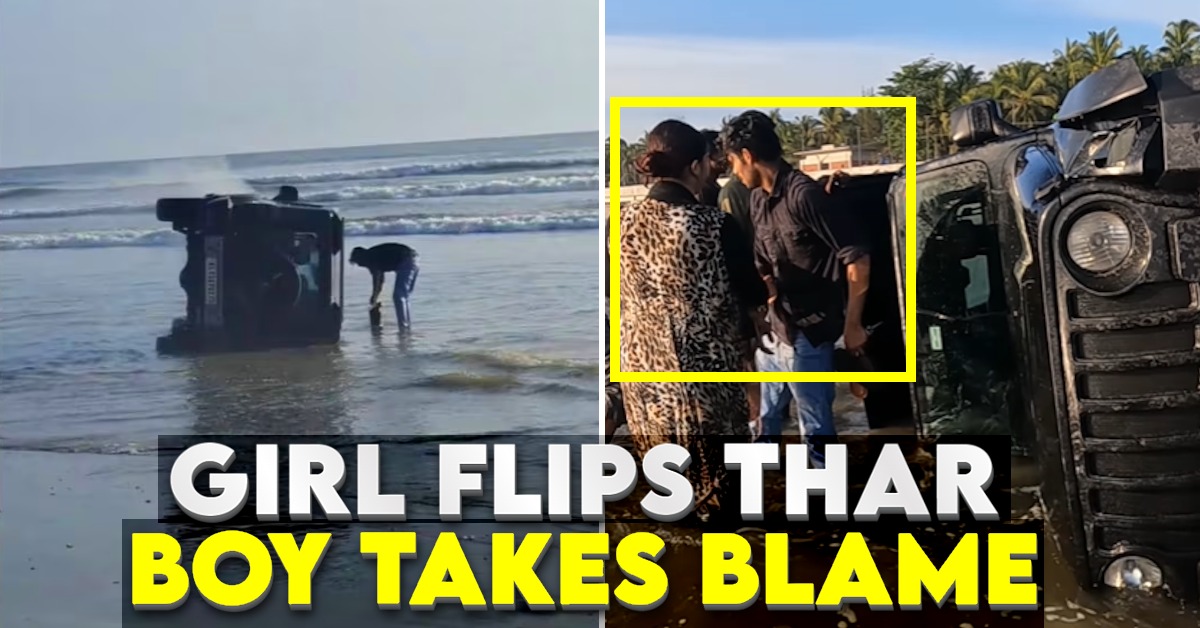Girl Flips Mahindra Thar On Muzhapillangad Drive-In Beach: Occupants Safe [Video]


Mahindra Thar is known for its ‘attitude’ and reel-worthiness. We have seen many owners do crazy stuff with it both on and off the camera. They have become infamous for doing stupid things with the vehicle just because they think the Thar can. Many times, we have also seen them land in trouble mid-way. One such incident happened recently at Muzhapillangad drive-in beach in Kerala, where a Thar was being driven fast when it lost control and flipped multiple times before coming to a halt.
Muzhapillangad is Asia’s longest drive-in beach. It is also the only one of its kind in India. Before we move into the details of this incident, it needs to be clarified that driving on beaches is illegal in India, and should not be attempted unless it is a drive-in beach.
The video shows a Black Mahindra Thar driving through the water at an ‘unsafe speed’, and losing control in no time. Many online reports say the speed was ‘high’. We would, however, refrain from calling it so, and settle down for the word ‘unsafe’. The speed should have been ‘high enough’ or unsafe for a low traction surface like sand that also has running water on it. In fact, the sea and its waves seem to have caused the mishap. The SUV was being driven through the water layer- possibly in an attempt to experience the splash or film the same.
It soon loses control and flips several times (as if in some movie) and finally comes to a standstill, resting on one of its sides. You can see fumes coming from the engine bay. If reports are to be believed, there were two in the Thar, one of which was a girl who was reportedly behind the wheel at the time of the crash. Both of them walked out without major injuries. The guy later took responsibility for the mishap, so that the lady remained safe. People soon rushed to the scene and the vehicle was later moved out using cranes and similar machines.
The vehicle took very little damage in what appears to be a horrific crash. The safety offered by the Thar is incredible. It had previously scored a 4-star safety rating for both adult and child protection in GNCAP crash tests and comes with a solid build.
The driver wasn’t expecting this turn of events while having a fun drive through the water. In fact, this accident needs to be attributed to the water layer involved. The phenomenon called ‘Aquaplaning’ seems to have made the vehicle lose control and rollover. Vehicles need proper traction between the wheels and the road surface to stay in control. When the road contact is compromised, it would behave differently as compared to otherwise and you’ll need expert skills to take back control.
Aquaplaning is when a layer of water gets in between the tyre and the road forming a slippery mid-layer that takes traction and control off the driver. In other words, the vehicle will lose its contact with the road. It would then freewheel with an extremely compromised manoeuvrability and braking. Even the slightest steering input would be critical then.
In this case, the seawater ( which is also in motion) could have easily made the mid-layer as the SUV was carrying enough speed. The presence of sand underneath instead of asphalt, would only have made things worse. The unforeseen intervention and loss of traction could have made the driver panic and she could have crashed out in an effort to recover.
When under hydroplaning, the vehicle becomes nearly unresponsive to braking, acceleration and steering. The faster you go, the easier it is for the phenomenon to kick in and cast an impact. Another thing which many miss while taking their vehicles to drive-in beaches is to have proper tyre pressure. You need to de-inflate the tyres before hitting the sand. Higher (read normal) tyre pressure will also increase the chance of aquaplaning.

The beach is not to be blamed for this. You can get to experience the phenomenon on highways as well. The monsoons usually create waterlogging in many of our highways. Speeding through this could also trigger aquaplaning and potentially invite bigger accidents. The depth of the water layer will also play a key role in the phenomenon. You should thus, exercise extra caution while tackling water-logged highways in the monsoons.